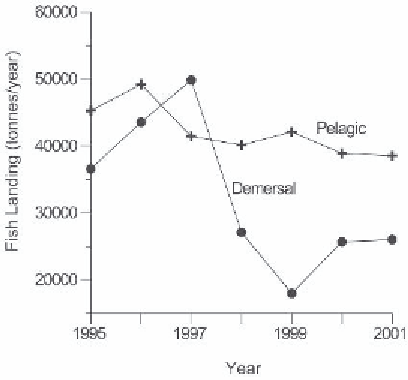Environmental Engineering Reference
In-Depth Information
(
Metapenaeus dobsoni
), if the fishing operations are permitted to be under-
taken during the period. The demersal fishes are driven into inshore waters
(estuaries and creeks), where they can be easily captured (once located, the
stocks of solar prawns are usually depleted in 2-3 days time due to intense
fishing).
Over the past few years there has been a substantial decrease in the demersal
fish catch along the coast of India, as exemplified by the data from the state of
Goa (Fig. 10). Significantly, a similar decline has not occurred in the case of
the pelagic fishes, and therefore it is reasonable to conjecture that the onset of
anoxic conditions (appearance of H
2
S) might be the main cause of the declining
demersal fish catch. Besides the adverse impact on fisheries, the O
2
deficiency
has been known to result in fish-kills when the fishes are unable to escape from
anoxic upwelled waters. Several instances of large scale fish-kills in the region,
apparently caused by asphyxiation, have been recorded in the literature, with
increasing recurrence in the last few years [37, 44].
Figure 10.
Annual pelagic and demersal fish landings in the state of Goa from 1995 to 2001
(courtesy Dr. Z.A. Ansari).
5.2 Geochemical Impact
Water-column Denitrification.
Direct measurements of denitrification rate
in the Arabian Sea through incubations of water samples spiked with
15
NO
3
−
yielded higher values (21.6
46.8 pM d
−
1
) for the coastal suboxic zone than
±
3.8 pM d
−
1
), apparently reflecting greater organic
carbon availability and higher temperatures over the shelf [17]. However, the
measured rates for the coastal zone are lower than expected from the nutrient
for the open-ocean one (8.8
±

